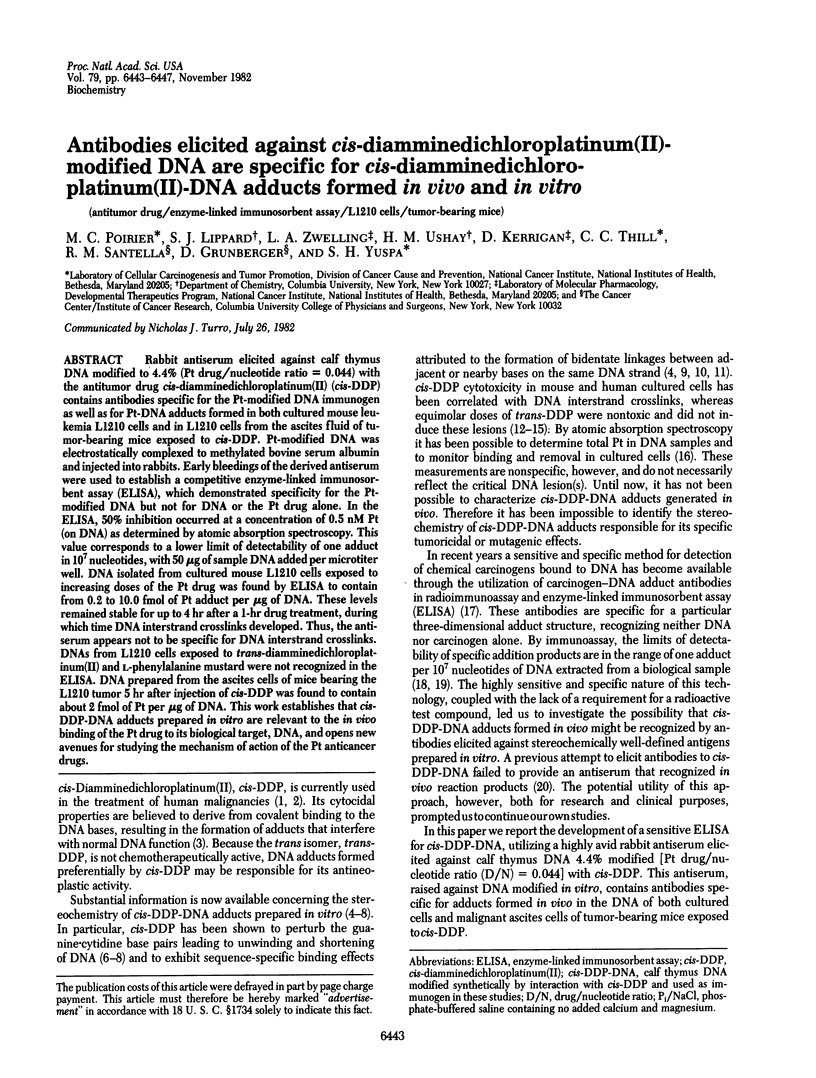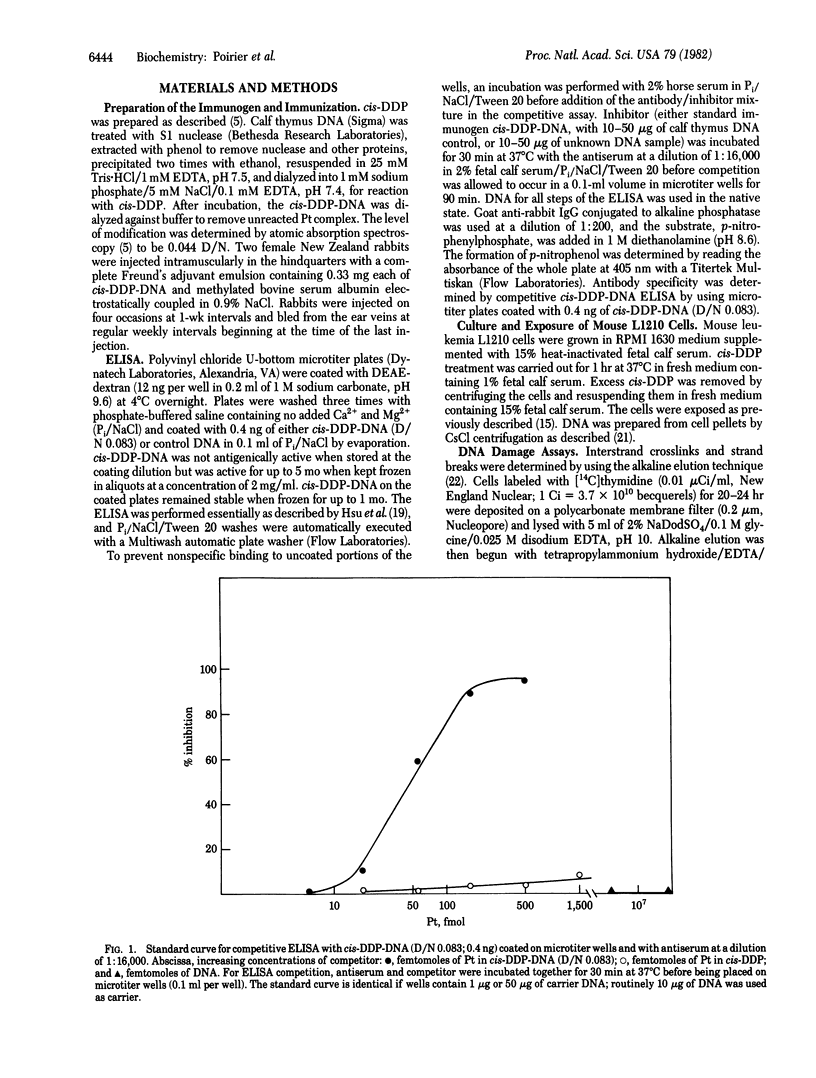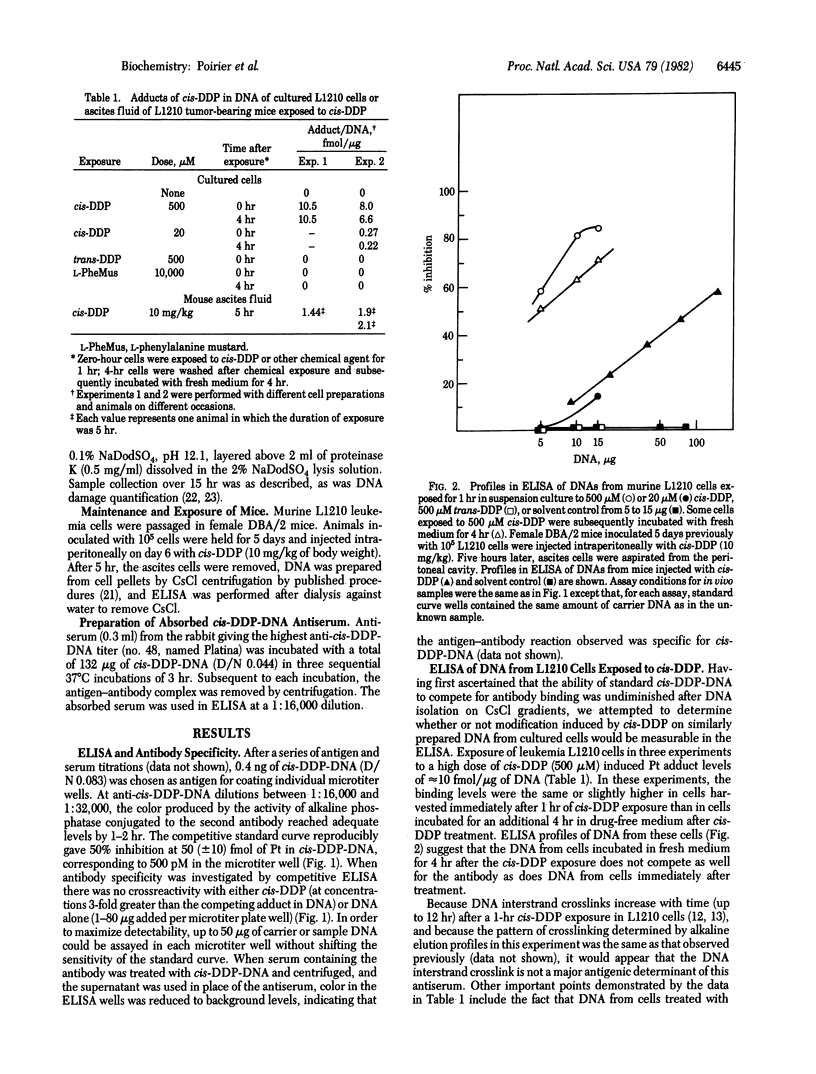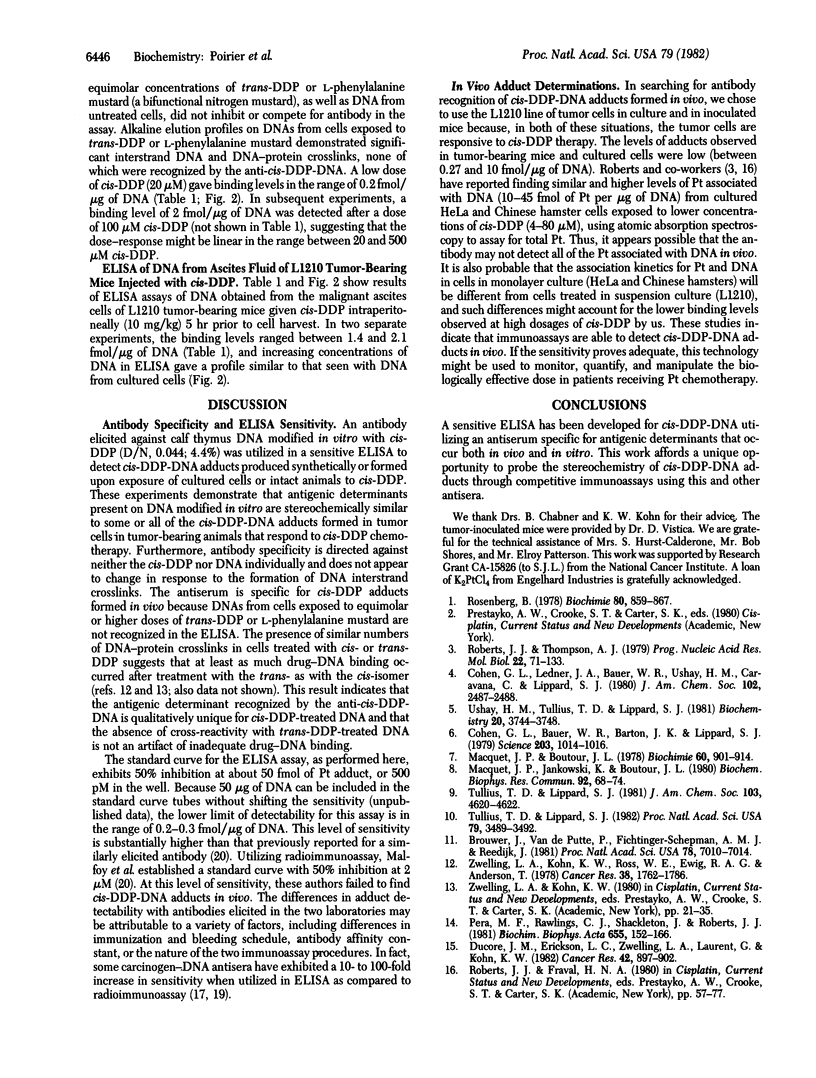Abstract
Rabbit antiserum elicited against calf thymus DNA modified to 4.4% (Pt drug/nucleotide ratio = 0.044) with the antitumor drug cis-diamminedichloroplatinum(II) (cis-DDP) contains antibodies specific for the Pt-modified DNA immunogen as well as for Pt-DNA adducts formed in both cultured mouse leukemia L1210 cells and in L1210 cells from the ascites fluid of tumor-bearing mice exposed to cis-DDP. Pt-modified DNA was electrostatically complexed to methylated bovine serum albumin and injected into rabbits. Early bleedings of the derived antiserum were used to establish a competitive enzyme-linked immunosorbent assay (ELISA), which demonstrated specificity for the Pt-modified DNA but not for DNA or the Pt drug alone. In the ELISA, 50% inhibition occurred at a concentration of 0.5 nM Pt (on DNA) as determined by atomic absorption spectroscopy. This value corresponds to a lower limit of detectability of one adduct in 10(7) nucleotides, with 50 micrograms of sample DNA added per microtiter well. DNA isolated from cultured mouse L1210 cells exposed to increasing doses of the Pt drug was found by ELISA to contain from 0.2 to 10.0 fmol of Pt adduct per microgram of DNA. These levels remained stable for up to 4 hr after a 1-hr drug treatment, during which time DNA interstrand crosslinks developed. Thus, the antiserum appears not to be specific for DNA interstrand crosslinks. DNAs from L1210 cells exposed to trans-diamminedichloroplatinum(II) and L-phenylalanine mustard were not recognized in the ELISA. DNA prepared from the ascites cells of mice bearing the L1210 tumor 5 hr after injection of cis-DDP was found to contain about 2 fmol of Pt per microgram of DNA. This work establishes that cis-DDP-DNA adducts prepared in vitro are relevant to the in vivo binding of the Pt drug to its biological target, DNA, and opens new avenues for studying the mechanism of action of the Pt anticancer drugs.
Full text
PDF




Selected References
These references are in PubMed. This may not be the complete list of references from this article.
- Brouwer J., van de Putte P., Fichtinger-Schepman A. M., Reedijk J. Base-pair substitution hotspots in GAG and GCG nucleotide sequences in Escherichia coli K-12 induced by cis-diamminedichloroplatinum (II). Proc Natl Acad Sci U S A. 1981 Nov;78(11):7010–7014. doi: 10.1073/pnas.78.11.7010. [DOI] [PMC free article] [PubMed] [Google Scholar]
- Cohen G. L., Bauer W. R., Barton J. K., Lippard S. J. Binding of cis- and trans-dichlorodiammineplatinum(II) to DNA: evidence for unwinding and shortening of the double helix. Science. 1979 Mar 9;203(4384):1014–1016. doi: 10.1126/science.370979. [DOI] [PubMed] [Google Scholar]
- Ducore J. M., Erickson L. C., Zwelling L. A., Laurent G., Kohn K. W. Comparative studies of DNA cross-linking and cytotoxicity in Burkitt's lymphoma cell lines treated with cis-diamminedichloroplatinum(II) and L-phenylalanine mustard. Cancer Res. 1982 Mar;42(3):897–902. [PubMed] [Google Scholar]
- Hsu I. C., Poirier M. C., Yuspa S. H., Grunberger D., Weinstein I. B., Yolken R. H., Harris C. C. Measurement of benzo(a)pyrene-DNA adducts by enzyme immunoassays and radioimmunoassay. Cancer Res. 1981 Mar;41(3):1091–1095. [PubMed] [Google Scholar]
- Macquet J. P., Jankowski K., Butour J. L. Mass spectrometry study of DNA-cisplatin complexes: perturbation of guanine-cytosine base-pairs. Biochem Biophys Res Commun. 1980 Jan 15;92(1):68–74. doi: 10.1016/0006-291x(80)91520-x. [DOI] [PubMed] [Google Scholar]
- Malfoy B., Hartmann B., Macquet J. P., Leng M. Immunochemical studies of DNA modified by cis-dichlorodiammineplatinum(II) in vivo and in vitro. Cancer Res. 1981 Oct;41(10):4127–4131. [PubMed] [Google Scholar]
- Pera M. F., Jr, Rawlings C. J., Shackleton J., Roberts J. J. Quantitative aspects of the formation and loss of DNA interstrand crosslinks in Chinese hamster cells following treatment with cis-diamminedichloroplatinum(II) (cisplatin). II. Comparison of results from alkaline elution, DNA renaturation and DNA sedimentation studies. Biochim Biophys Acta. 1981 Sep 28;655(2):152–166. doi: 10.1016/0005-2787(81)90005-8. [DOI] [PubMed] [Google Scholar]
- Poirier M. C. Antibodies to carcinogen-DNA adducts. J Natl Cancer Inst. 1981 Sep;67(3):515–519. [PubMed] [Google Scholar]
- Poirier M. C., Santella R., Weinstein I. B., Grunberger D., Yuspa S. H. Quantitation of benzo(a)pyrene-deoxyguanosine adducts by radioimmunoassay. Cancer Res. 1980 Feb;40(2):412–416. [PubMed] [Google Scholar]
- Roberts J. J., Thomson A. J. The mechanism of action of antitumor platinum compounds. Prog Nucleic Acid Res Mol Biol. 1979;22:71–133. doi: 10.1016/s0079-6603(08)60799-0. [DOI] [PubMed] [Google Scholar]
- Tullius T. D., Lippard S. J. Ethidium bromide changes the nuclease-sensitive DNA binding sites of the antitumor drug cis-diamminedichloroplatinum(II). Proc Natl Acad Sci U S A. 1982 Jun;79(11):3489–3492. doi: 10.1073/pnas.79.11.3489. [DOI] [PMC free article] [PubMed] [Google Scholar]
- Ushay H. M., Tullius T. D., Lippard S. J. Inhibition of the BamHI cleavage and unwinding of pBR322 deoxyribonucleic acid by the antitumor drug cis-dichlorodiammineplatinum(II). Biochemistry. 1981 Jun 23;20(13):3744–3748. doi: 10.1021/bi00516a012. [DOI] [PubMed] [Google Scholar]
- Zwelling L. A., Kohn K. W., Ross W. E., Ewig R. A., Anderson T. Kinetics of formation and disappearance of a DNA cross-linking effect in mouse leukemia L1210 cells treated with cis- and trans-diamminedichloroplatinum(II). Cancer Res. 1978 Jun;38(6):1762–1768. [PubMed] [Google Scholar]
- Zwelling L. A., Michaels S., Erickson L. C., Ungerleider R. S., Nichols M., Kohn K. W. Protein-associated deoxyribonucleic acid strand breaks in L1210 cells treated with the deoxyribonucleic acid intercalating agents 4'-(9-acridinylamino) methanesulfon-m-anisidide and adriamycin. Biochemistry. 1981 Nov 10;20(23):6553–6563. doi: 10.1021/bi00526a006. [DOI] [PubMed] [Google Scholar]


